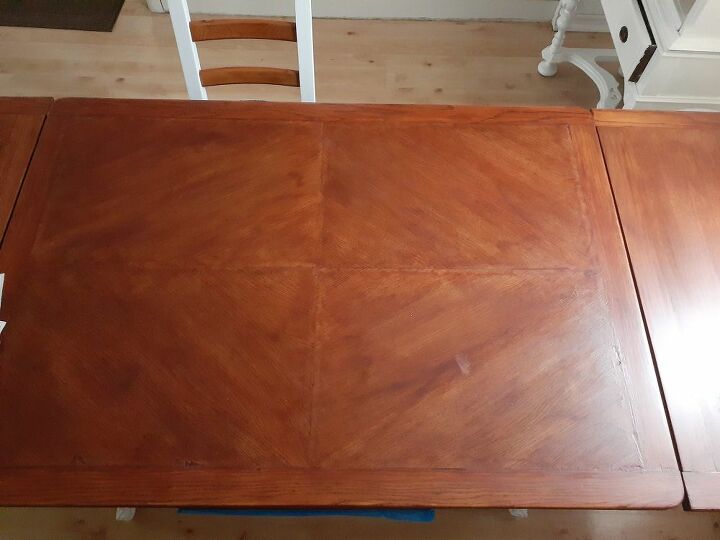What can I use to smooth off a dining room tabletop?
I refinished my dining tabletop with satin oil based varathane but I would like to smooth it out. Any recommendations such as using wax?
Related Discussions
How to get rid of mice?
We seem to have some unwelcome Mickeys and Minnies in our house. What is the best way to get rid of them?
How to remove popcorn ceiling with asbestos?
I want to remove my popcorn ceiling, but it has asbestos in it. How do I go about this safely?
How to caulk baseboard gaps?
How do I fill gaps at baseboard, should I caulk? If so, does anyone know how to caulk baseboards?
How to fix squeaky hardwood floors?
How do I fix squeaky hardwood floors?
What can I use for a flat on/off light switch that won't yellow?
We built our house 15 years ago. We had flat on/off light switches installed. All of them have yellowed/discolored and are no longer white. One dimmer switch that ... See more
What can I use to line, or seal off, a concrete bird bath?
I have a concrete bird bath that I love. But when it is filled with water it leaches some kind of red material from the concrete itself into the water. I feel this ma... See more





Oil based varathane is a polyurethane and will protect the wood. If the finish isn't smooth, you may need to give it a light sanding with fine sandpaper or steel wool, wipe away the dust and apply another coat of varathane.
I did that 4 times. The biggest problem is that the grain of the inlays go in different directions and it's almost impossible to get good long smooth brush strokes. I was wondering if I could use a wax over it?
I too would suggest using 000 steel wool and recoating. If it is still uneven, you could put a pretty table cover on the diagonal where the corners meet.
The thing about finishing is to ‘finish the finish’. What I mean is that you have to sand between coats. If you do this the end product will be very smooth. The problem you might encounter is if you didn’t sand after the first coat. This would mean there are ‘nibs’ (small dirt and dust particles) that are embedded underneath subsequent coats. If this is the case the only fix is to sand the finish completely off and begin anew making sure to sand between coats. Sand until the finish is perfectly smooth, then apply the next coat. I recommend three coats of finish.
Another important consideration is the type of finish. I recommend lacquer because it dries extremely fast. You want something fast drying because the longer the ‘open time’ (time that the finish is wet and tacky), the more dirt and debris can settle on the finish. Polyurethane, varnish, shellac, and other similar products have long open times, and thus a lot of foreign matter collects on the finish. Lacquer is also easily repaired because putting additional lacquer on top of an existing coat melts the top coat and the two blend together. There is no other finish that does this. As far as brands, I recommend Minwax Brushing Lacquer. I spray my finishes but it works equally well with a brush. I have been using it for probably 20 years in my shop and it’s a great product. If you follow these steps you will have the smooth finish you’re looking for.
Try a 600 or 800 grit sandpaper and remove that dust with a barely damp rag then go from there.
Bennet - I realize you don't want to redo the effort you've already put in but your choices are really to either live with it as is or sand/strip off the poly and redo it. Putting lacquer over the poly won't fix your issue.
Try sanding the worse "bumps" with a fine sandpaper to see how far in it is. If you're lucky, you can get rid of them without a full strip.
Should have used water based poly and a foam brush. No brush strokes and flows on smoothly. At this point wax will not do anything. Lacquer needs to be sprayed to get a smooth finish. Like the clearcoat on a car. It's also solvent based. What I would do use a green kitchen scrubby and lightly sand the finish. Apply three coats of a water based poly sanding in between coats with the green pad. Also use a foam brush and not the dollar store kind.
If you choose to try as William says (he knows a lot!), I'd use a 000 steel wool rather than a scrubby to sand between coats. Also make sure you get ALL the stuff off the surface between coats.
It is OK to use a water-based polyurethane over an oil-based finish in good condition. “Roughen” the surface finish lightly with medium or fine-grit sandpaper or a green kitchen scrubby (it's what I use) in the direction of the grain. You want to remove the gloss from the finish. Remove all the dust with a vacuum, tack rag, or damp cloth. Steel wool can leave shards of metal embedded in the wood you won't notice until you apply the finish.
The advantage of the water-based finish is ease of use, quick drying (usually 2 hours), no odor, and easy cleanup. Both water based and oil based poly offer good protection; the biggest difference is in appearance.
Oil-based polyurethanes leave an amber glow and require fewer coats. But the five-hour wait between coats and 12-hour wait after the last coat will put the table out of commission for a few days—and you’ll have to put up with a strong odor.
Water-based polyurethanes provide a clear finish and have low odor. You can recoat them in two hours and clean your tools with water. If you start early enough in the day, you can apply the recommended three coats. It’s actually the most durable hardwood floor finish so it it does offer durability on furniture.
No staining. Your just removing the gloss and putting a new clearcoat on to smooth the surface. Make sure you use a foam brush in long strokes. Water based goes on milky white but dries clear. It's all I ever use.